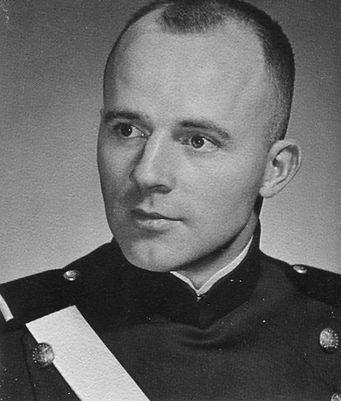* Site Under Construction *
Henry David Canterbury
Henry David Canterbury
Years of Service:
34
Highest Rank:
O-8
Medals & Awards:
Air Force Distinguished Service Medal 1
Defense Superior Service Medal 1
Legion of Merit 2
Distinguished Flying Cross 2
Bronze Star Medal 1
Meritorious Service Medal 1
Air Medal 21
Career Highlights:
Major General Henry “Hank” D. Canterbury from Huntsville, Alabama, is a distinguished member of the inaugural graduating U.S. Air Force Academy Class of 1959, earning a Bachelor of Science degree. He furthered his education with a Master's degree in Systems Management from the University of Southern California. His military education includes completing the Armed Forces Staff College and the National War College.
Following his commissioning as a second lieutenant in 1959, attended flight training at Spence Air Base, Georgia, and Vance Air Force Base, Oklahoma, receiving his pilot's wings in July 1960. He then underwent F-100 combat crew training at Luke Air Force Base, Arizona, and Nellis Air Force Base, Nevada. In 1961, he began a three-year tour of duty at Spangdahlem Air Base, West Germany, where he flew F-100s and F-105s with the 9th Tactical Fighter Squadron, 49th Tactical Fighter Wing.
Returning to the United States in 1964, Canterbury served with the 333rd Tactical Fighter Squadron at Eglin Air Force Base, Florida, flying F-105s. This unit was assigned to the Tactical Air Warfare Center, focusing on testing and evaluating tactics, procedures, and equipment concepts. He then moved to Nellis Air Force Base to join the Air Force aerial demonstration team, the Thunderbirds, flying F-100s in the slot position. During his two years with the team, he participated in more than 230 air shows worldwide.
In July 1967, en route to Southeast Asia, he completed the Fighter Weapons School at Nellis. He then served a 12-month tour of duty with the 3rd Tactical Fighter Wing at Bien Hoa Air Base, Republic of Vietnam, from 1967 to 1969. As chief of the Weapons and Tactics Division, he flew 286 combat missions in F-100s. During this tour, he experienced an incident where his F-100 engine quit while heavily loaded and flying low over the South China Sea. After jettisoning bombs and fuel tanks and attempting to restart the engine without success, he ejected from the aircraft. He landed in the water and was eventually rescued after about an hour, an event he described as "kind of an exciting time." From 1972 to 1973, his squadron was on temporary duty for six months to Ubon Royal Thai Air Force Base, Thailand, where he flew an additional 90 combat missions in F-4Es.
Canterbury's career progressed through various significant staff and command positions. In July 1968, he was assigned to Headquarters U.S. Air Force, Washington, D.C., as an action officer with the Deputy Chief of Staff for Plans and Operations, Directorate of Operations. From 1969 to 1970, he served as executive officer to the Vice Commander in Chief of U.S. Air Forces in Europe at Lindsey Air Station, West Germany. He then moved to Randolph Air Force Base, Texas, serving as executive officer to the Commander of Air Training Command from September 1970 to June 1971.
After graduating from the Armed Forces Staff College in June 1972, he served successively with the 31st Tactical Fighter Wing at Homestead Air Force Base, Florida, as a flight commander, operations officer, and commander of the 308th Tactical Fighter Squadron. Following his graduation from the National War College in July 1976, he returned to Air Force Headquarters as Assistant Deputy Director for Combat Readiness in the Directorate of Operations and Readiness until June 1977.
In June 1978, he became Vice Commander of the 4th Tactical Fighter Wing at Seymour Johnson Air Force Base, North Carolina. In 1979, he took command of the 56th Tactical Fighter Wing at MacDill Air Force Base, Florida, overseeing its conversion to F-16s. Canterbury transferred to Luke Air Force Base in 1982, taking command of the 26th Air Division and the 26th North American Aerospace Defense Command Region. In May 1982, he became commander of Tactical Air Command's 832nd Air Division at Luke.
In December 1984, he was appointed Deputy Commander in Chief of U.S. Southern Command, Quarry Heights, and Commander, U.S. Air Force Southern Air Division, Howard Air Force Base, Panama. In this role, he was responsible for U.S. Air Force matters in Latin America and served as the Joint Chiefs of Staff representative to those Air Forces. He assumed his final active duty assignment in February 1987 as Vice Commander of 9th Air Force, Tactical Air Command, headquartered at Shaw Air Force Base, South Carolina.
A command pilot, Major General Canterbury logged more than 5,000 flying hours in a variety of aircraft, including F-100s, F-105s, F-4s, F-16s, F-15s, and A-10s. He was promoted to major general on August 1, 1985.
Major General Henry D. Canterbury retired from the U.S. Air Force on July 1, 1989.
